Pasargadae: Legacy of Cyrus the Great & Ancient City
Pasargadae, an ancient city located in present-day Iran, holds immense historical significance as the capital of the Achaemenid Empire and the final resting place of one of history's most renowned leaders, Cyrus the Great.
Founded by Cyrus himself in the 6th century BCE, Pasargadae stands as a testament to the architectural prowess and urban planning of the ancient world. The importance of Pasargadae in history cannot be overstated. It served as the political and cultural center of the vast Achaemenid Empire, a sprawling dominion that encompassed multiple civilizations and made significant contributions to art, architecture, and governance.
At the heart of Pasargadae's legacy lies Cyrus the Great, a visionary and benevolent ruler who laid the foundation for human rights and religious tolerance. Known for his compassionate governance and military prowess, Cyrus' accomplishments continue to inspire leaders and thinkers to this day.
As we explore the wonders of Pasargadae and explore the legacy of Cyrus the Great, we gain a deeper understanding of the ancient world's sophistication and the enduring impact of visionary leadership on human civilization.
Historical background
The Achaemenid Empire, founded by Cyrus the Great, emerged as a dominant force in the ancient world during the 6th century BCE. Under Cyrus' visionary leadership, the empire expanded its boundaries to encompass vast territories, including modern-day Iran, Iraq, Egypt, and parts of Turkey and Central Asia. The Achaemenid rulers implemented a centralized administration, fostering cultural exchange and encouraging the use of local languages and customs within their diverse domains. This empire's vastness and diversity laid the groundwork for the cosmopolitan and multifaceted society that thrived in Pasargadae.
Cyrus the Great's Achievements and Reign

In the heart of Persis, Cyrus chose a picturesque location surrounded by fertile plains and majestic mountains to establish Pasargadae as the capital of his empire. The decision to build Pasargadae was not solely based on its strategic position, but also on its symbolic significance. It was in this region that Cyrus had achieved significant military victories and laid the foundation for his empire. Moreover, Pasargadae's establishment served as a testament to Cyrus' humble origins, as he was born in the nearby city of Anshan. The construction of Pasargadae became a testament to Cyrus' vision for a harmonious and powerful empire, reflecting his commitment to creating a utopia where diverse cultures and beliefs could flourish in harmony.
| Suggestion: Naqsh-e Rustam | Ancient Treasures & Zoroastrian Legacy
Pasargadae: The Capital City
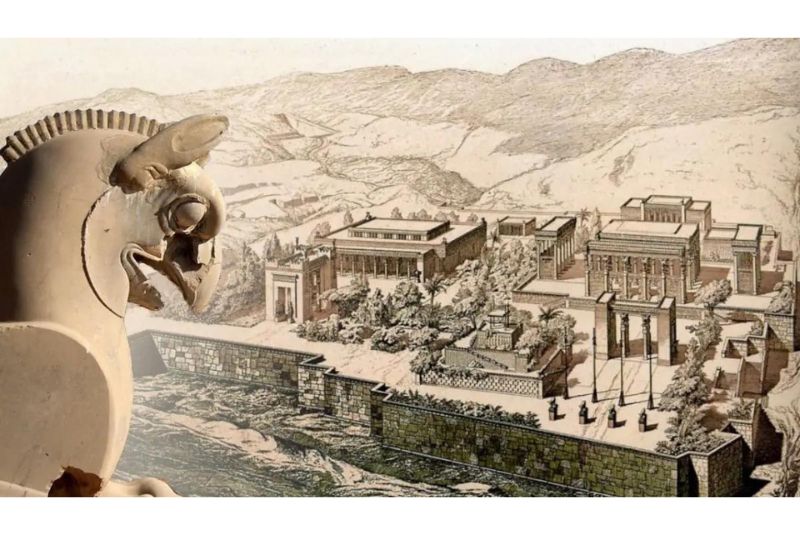
Situated in the heart of ancient Persia, Pasargadae held a strategic location at the crossroads of important trade routes, making it a vital center for commerce and cultural exchange. Surrounded by fertile plains and bordered by the towering Zagros Mountains, the city's natural landscape not only provided protection but also added to its scenic allure. The nearby Cyrus River, flowing through the city, ensured a steady water supply for its inhabitants and agricultural needs, contributing to the city's prosperity and development.
| Related: Persepolis; The Great Ancient Persian Capital
Architectural Marvels
The Gatehouse
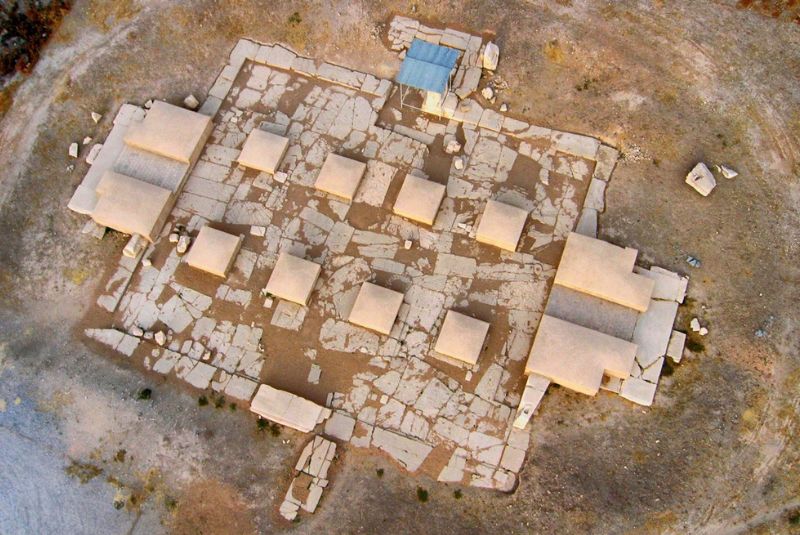
At the entrance to Pasargadae stood an impressive Gatehouse, also known as the Gate of All Nations. This grand structure served as a symbol of the empire's unity and diversity. Its monumental entrance showcased intricate carvings and inscriptions representing various subject nations, reflecting the Achaemenid Empire's multicultural identity.
The Audience Hall (Apadana)
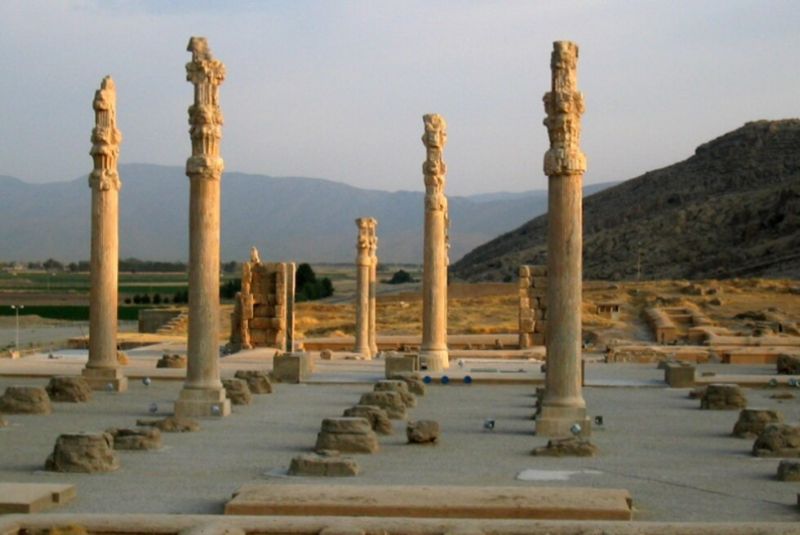
The Apadana, an awe-inspiring audience hall, was the focal point of Pasargadae's urban planning. This vast terrace was designed to host grand ceremonies and official gatherings. Supported by massive columns and adorned with ornate carvings, the Apadana exemplified the architectural brilliance of the Achaemenid era.
| Discover: Arg-e Bam | The Fascinating Citadel of Ancient Persia
The Residential Palace
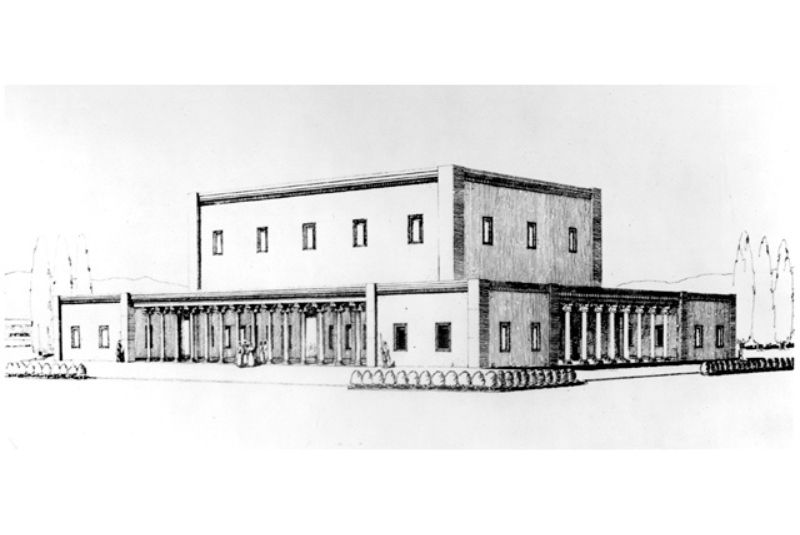
Cyrus the Great's Residential Palace, an opulent structure located within Pasargadae, displayed a combination of Persian and Median architectural styles. The palace's layout and design showcased the Achaemenid kings' luxurious lifestyle, while its surrounding gardens added to its splendor.
The Gardens

Pasargadae was renowned for its well-designed gardens, known as "paradises" in Persian culture. These gardens not only provided a serene retreat for the city's residents but also served as a symbol of Persian kings' power and their ability to create lush, green oases in arid landscapes.
Cultural and Religious Aspects
The Cyrus Cylinder and Human Rights
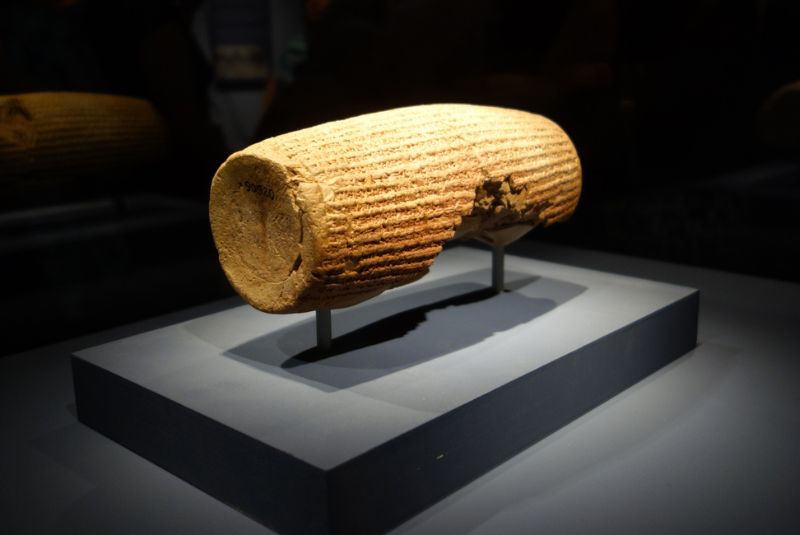
Among the most significant artifacts discovered in Pasargadae was the Cyrus Cylinder. This ancient clay cylinder contained an edict attributed to Cyrus the Great, outlining his policy of religious and cultural tolerance and granting freedom to captive populations. The Cylinder is considered one of the earliest declarations of human rights in history, emphasizing the importance of respect and kindness towards all subjects.
Temples and Religious Structures
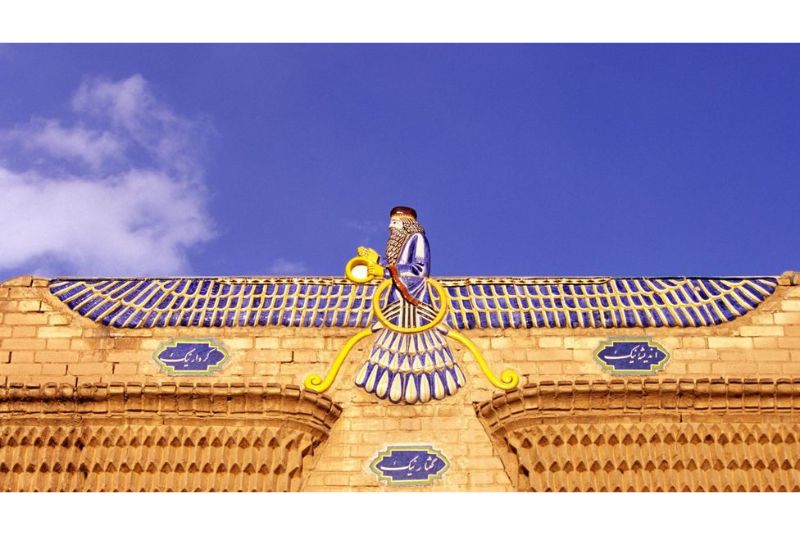
Pasargadae housed various religious structures, reflecting the empire's diverse religious practices. The city's temples were dedicated to different deities, representing the religious plurality that Cyrus embraced as a fundamental aspect of his rule.
| Learn more: Takhte Soleyman | Throne of Solomon
Influence of Pasargadae on Future Cities and Cultures
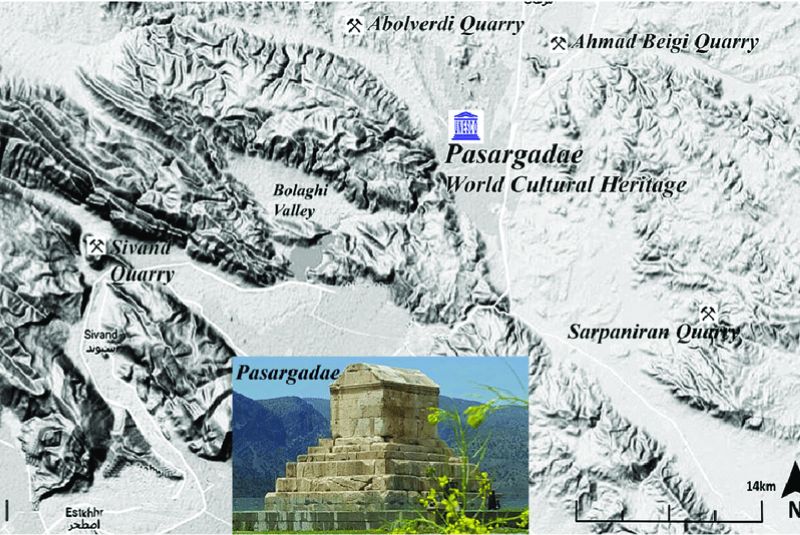
Pasargadae's architectural and urban planning achievements left an indelible mark on future cities and cultures. Its emphasis on grandeur and inclusivity in design inspired subsequent civilizations, including those of Greece and Rome. Moreover, the principles of religious tolerance and respect for human rights espoused by Cyrus the Great continue to resonate with modern societies, exemplifying the enduring legacy of Pasargadae and its remarkable founder.
The Tomb of Cyrus the Great
The Tomb of Cyrus the Great, an iconic historical monument within Pasargadae, holds a place of reverence and mystery. Located on a remote hillside overlooking the city, the tomb was strategically positioned to afford the great king eternal rest in a serene and majestic setting. The tomb's architectural design is a testament to the sophisticated engineering skills of the Achaemenid era. It consists of a simple, rectangular chamber built from massive limestone blocks, topped with a soaring, stepped roof resembling a Ziggurat. This unique design blends Persian and Median architectural influences, reflecting the empire's diverse cultural heritage.

Historical Accounts of Cyrus' Burial
The accounts of Cyrus the Great's burial are shrouded in both history and legend. According to ancient records, when Cyrus met his end in 530 BCE during a military campaign, his remains were transported back to Pasargadae for burial. His final resting place was intended to be a place of eternal peace, away from the turmoil of the world he once ruled. Herodotus, the Greek historian, mentioned the tomb's existence during his travels to Persia, contributing to its historical significance.
The Tomb's Significance as a Pilgrimage Site
The Tomb of Cyrus the Great became a revered pilgrimage site throughout history. Visitors, including rulers, religious leaders, and ordinary people, journeyed from far-flung lands to pay homage to the great king and seek blessings at his tomb. The site's significance extended beyond the borders of the Achaemenid Empire, with travelers from neighboring civilizations coming to offer their respects, further cementing Cyrus' legacy as a benevolent ruler respected even by foreign cultures.
| Read more: Tehran Palaces | Iran's Historical & Cultural Heritage
Preservation Efforts and Challenges
Preserving the Tomb of Cyrus the Great has been a continuous effort to safeguard this invaluable historical treasure. The site faces various challenges, including environmental factors such as erosion and seismic activity, as well as human-induced threats such as vandalism and tourism impact. Conservation initiatives led by Iranian authorities and international organizations have sought to protect and restore the tomb and its surroundings. Careful restoration work and controlled access to the site have been implemented to strike a balance between preserving its integrity and allowing visitors to experience its historical and spiritual significance.
Rediscovery and Archaeological Excavations

Following the death of Cyrus the Great in 530 BCE, Pasargadae experienced a gradual decline over the centuries. The capital city lost its political and administrative significance as subsequent Achaemenid kings favored other cities as their centers of power. Additionally, the city faced challenges from external invasions and internal conflicts, contributing to its eventual decline. As the Achaemenid Empire fell to Alexander the Great in the 4th century BCE, Pasargadae's status as a prominent city waned further, and it eventually faded into obscurity.
Pasargadae remained lost to history until the 19th century when European explorers and archaeologists began to search for the remnants of ancient civilizations in the region. In the early 19th century, scholars, including Sir William Jones and Sir Robert Ker Porter, showed a keen interest in the historical significance of ancient Persian sites. However, it was not until the mid-20th century, under the Pahlavi dynasty, that systematic archaeological excavations were initiated in Pasargadae.
The rediscovery of Pasargadae led to significant archaeological findings that shed light on the Achaemenid Empire's splendor and Cyrus the Great's legacy. Excavations at the site unearthed the impressive ruins of the Gatehouse, the Audience Hall (Apadana), and the Residential Palace, displaying the city's architectural magnificence. The discovery of the Tomb of Cyrus the Great provided invaluable insights into ancient burial practices and beliefs surrounding death and the afterlife.
One of the most significant discoveries was the Cyrus Cylinder found in Babylon but closely connected to Pasargadae's history. The cylinder, inscribed with the edict of Cyrus the Great, highlighted his principles of tolerance and respect for diverse cultures, emphasizing the importance of human rights even in ancient times.
The findings at Pasargadae have enriched our understanding of the Achaemenid civilization's achievements and further solidified the legendary status of Cyrus the Great. These archaeological treasures continue to attract scholars, historians, and tourists alike, drawing attention to the enduring legacy of Pasargadae and its profound impact on human history. Through ongoing excavations and preservation efforts, we can continue to uncover the secrets of this ancient capital and ensure its preservation for future generations to marvel at the greatness of the past.
| Also might be interesting: Vank Cathedral | Persian & Armenian Cultural Masterpiece
Pasargadae's World Heritage Status

In recognition of its exceptional cultural and historical value, Pasargadae was inscribed as a UNESCO World Heritage Site in [insert year of inscription]. This prestigious designation acknowledges Pasargadae's significance as a unique testament to the Achaemenid Empire's grandeur and the enduring legacy of Cyrus the Great. The inscription placed Pasargadae among the world's most treasured cultural and historical sites, elevating its status and highlighting the need for its preservation and protection for future generations.
Pasargadae's World Heritage status attracts tourists, scholars, and history enthusiasts from around the world, boosting cultural tourism and fostering cross-cultural understanding. The preservation of this historical site contributes to sustainable development and economic benefits for the local community, encouraging responsible tourism practices that respect the site's integrity.
Visiting Pasargadae Today
Visiting Pasargadae today has become more accessible than ever before. Situated in Fars Province, Iran, the ancient site is reachable from major cities like Shiraz, which is approximately 130 kilometers away. Travelers can access Pasargadae through well-maintained roads, and various transportation options are available, including private vehicles, taxis, and organized tours.
For international visitors, Shiraz International Airport serves as the main entry point. The airport offers regular flights connecting major international destinations, making it convenient for travelers from around the world to embark on their journey to Pasargadae.
| Discover: Is Iran Safe for Tourists?
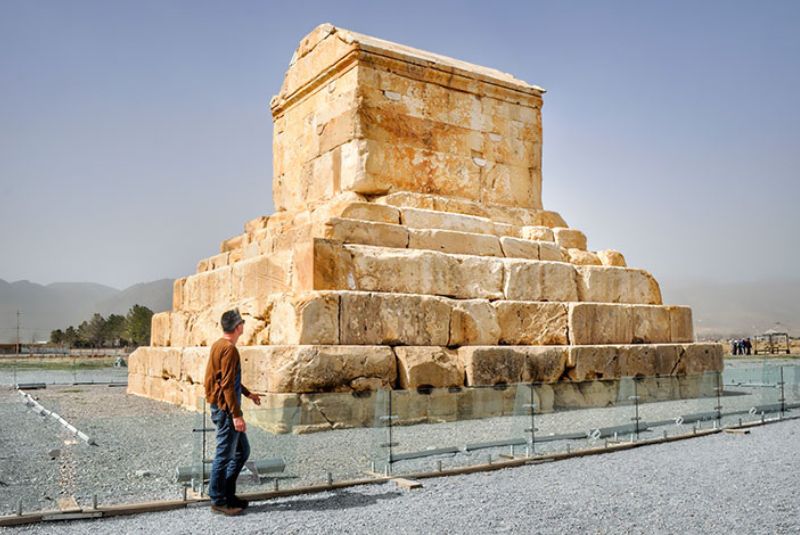
Visitor Facilities and Accommodations
Pasargadae welcomes tourists with modern visitor facilities to enhance their experience while preserving the site's historical integrity. Upon arrival, visitors will find information centers and guides who provide insights into the historical significance of the ancient capital. Educational materials, maps, and audio guides are also available to enrich the visitor's understanding of the site's cultural and architectural wonders.
While accommodation options directly at Pasargadae are limited due to its historical nature, visitors can find comfortable hotels and guesthouses in nearby cities like Shiraz. These accommodations cater to various budgets and preferences, offering a relaxing stay after a day of exploration at the ancient site.
Must-See Attractions
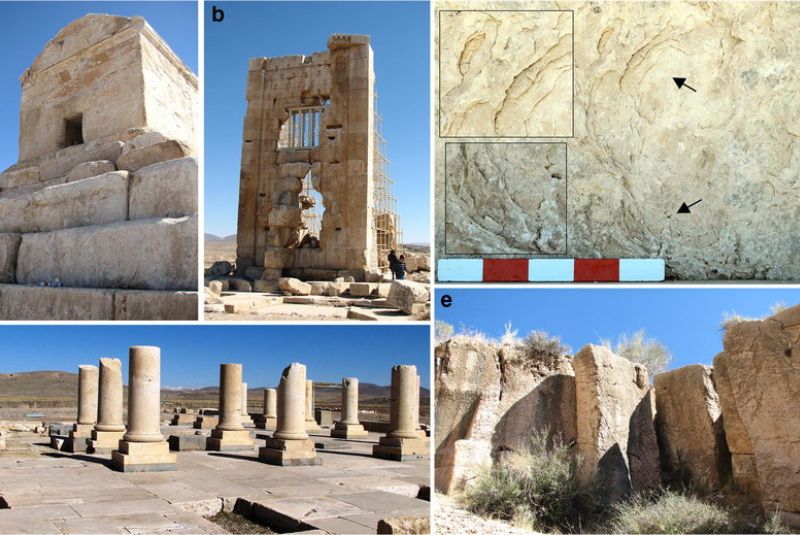
Pasargadae boasts a plethora of awe-inspiring highlights that captivate visitors and provide a glimpse into the ancient world's magnificence. Some must-see attractions include:
- The Tomb of Cyrus the Great: The most significant and iconic structure in Pasargadae, the Tomb of Cyrus stands as a testament to the empire's profound respect for its benevolent founder. Visitors can pay their respects to the great king at this monumental site.
- The Gatehouse: The impressive Gatehouse, or Gate of All Nations, is a mesmerizing entrance adorned with intricate carvings representing diverse subject nations of the Achaemenid Empire. It serves as a grand introduction to the ancient city's grandeur.
- The Audience Hall (Apadana): The Apadana, an imposing audience hall, is a highlight of Pasargadae's urban planning. Its vast terrace and grand columns evoke the opulence of the Achaemenid era, where ancient ceremonies and official gatherings once took place.
- The Residential Palace: Cyrus the Great's Residential Palace showcases the luxurious lifestyle of Achaemenid kings. Its architectural beauty and surrounding gardens offer insight into the elite's way of life during the empire's zenith.
- Pasargadae Gardens: The lush gardens often referred to as "paradises," provide a serene escape for visitors to appreciate the ancient Persians' horticultural prowess.
Visiting Pasargadae today is a journey through time, offering a captivating blend of history, art, and culture. With accessible transportation, modern visitor facilities, and a wealth of remarkable attractions to explore, Pasargadae promises an unforgettable experience that resonates with the greatness of its past.
| Suggestion: Top Iranian Handicrafts You Should Know
Bottom Line
Pasargadae stands as an extraordinary testament to the grandeur and cultural brilliance of the Achaemenid Empire. As the capital city founded by the visionary leader Cyrus the Great, Pasargadae holds a pivotal place in history. Its strategic location, architectural marvels, and cultural richness showcase the empire's multicultural identity and its commitment to fostering an inclusive and enlightened society.
Pasargadae stands as an eternal monument to the magnificence of the Achaemenid Empire and the wisdom of Cyrus the Great. Let us embrace the spirit of exploration and embark on a journey to discover and cherish the ancient wonders that continue to inspire us, ensuring that the legacy of Pasargadae remains alive in the hearts and minds of generations to come.


Comment
Leave a Comment